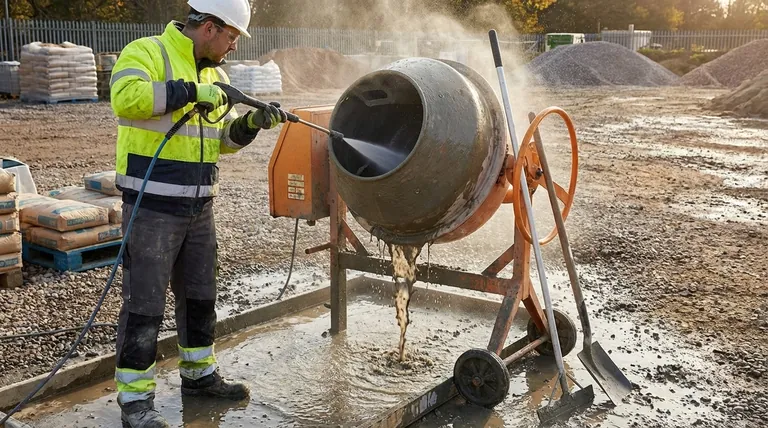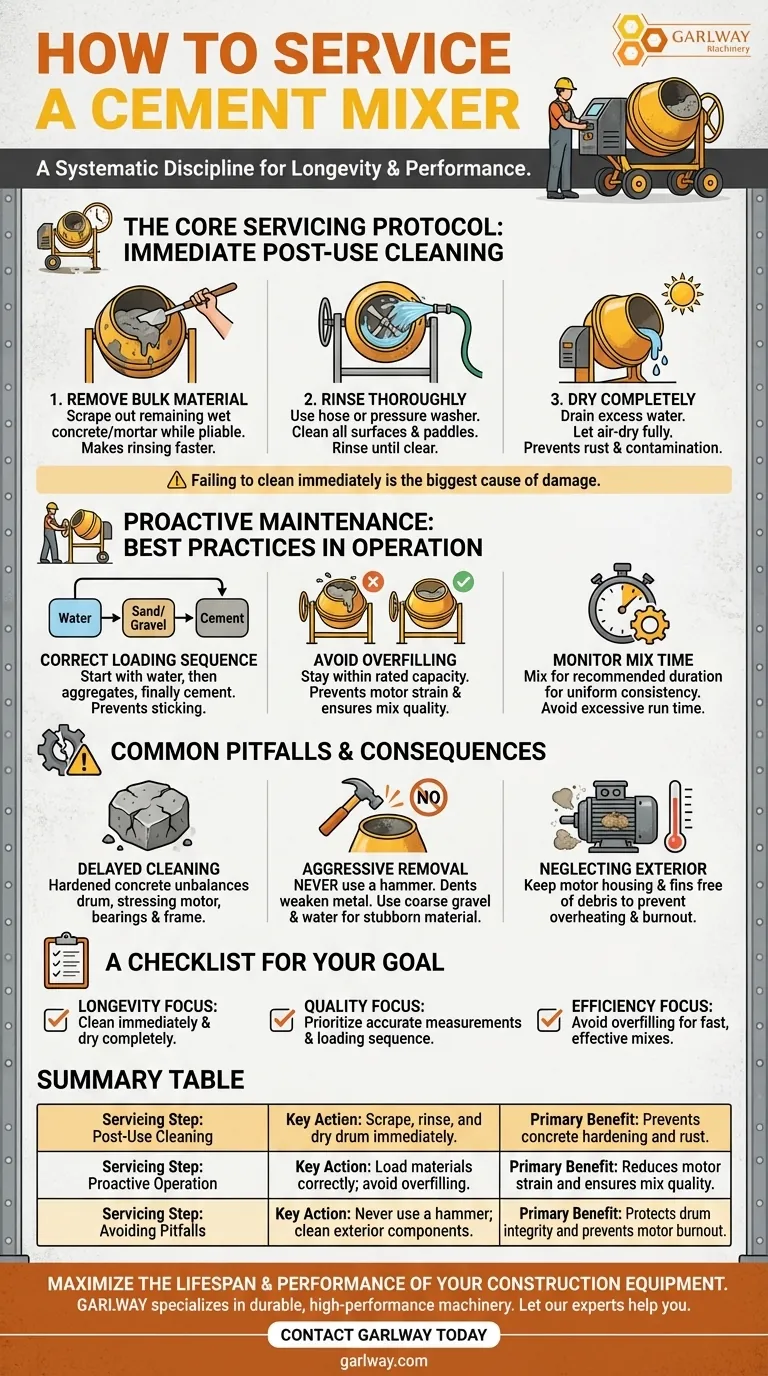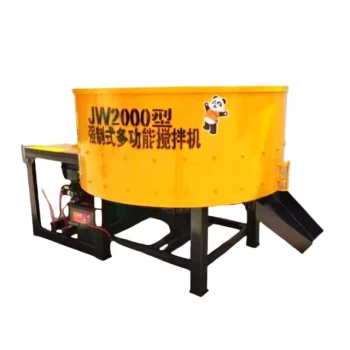Properly servicing a cement mixer is a straightforward process centered on immediate and thorough cleaning after every use. The essential steps are to mechanically scrape out all excess wet material, rinse the drum completely with clean water until it runs clear, and allow the interior to dry fully before storage.
Effective cement mixer servicing is not just about cleaning. It is a systematic discipline combining correct operational procedures with immediate post-use maintenance to guarantee machine longevity, prevent failures, and ensure consistent mix quality.

The Core Servicing Protocol: Post-Use Cleaning
Failing to clean a mixer immediately is the single biggest cause of damage and poor performance. Concrete begins to harden quickly, making it exponentially more difficult to remove with each passing minute.
Step 1: Remove Bulk Material
As soon as the drum is empty, use a long-handled scraper or shovel to remove any remaining wet concrete or mortar.
This initial step removes the vast majority of the material while it is still pliable, making the subsequent rinsing stage much faster and more effective.
Step 2: Rinse Thoroughly
Use a garden hose or a pressure washer to rinse the inside of the drum.
Rotate the drum while spraying to ensure you clean all surfaces, including the mixing paddles. Continue rinsing until the water running out of the drum is completely clear.
Step 3: Dry Completely
Once clean, tilt the drum downward to allow all excess water to drain out.
Letting the drum air-dry completely is crucial. Storing the mixer with water inside will lead to rust, which compromises the integrity of the drum and can contaminate future batches.
Proactive Maintenance: Best Practices in Operation
True servicing begins before the mix even starts. How you operate the machine has a direct impact on its lifespan and makes the cleaning process significantly easier.
The Correct Loading Sequence
Always add materials in the correct order. Start with about half of the required water before adding sand, gravel, and finally, the cement.
Adding water first prevents dry cement and aggregates from sticking to the drum's interior, which is a primary cause of stubborn buildup.
Avoiding Overfilling
Never load the mixer beyond its rated capacity. Overfilling puts immense strain on the motor and drive components, leading to premature wear and potential failure.
An overfilled drum also cannot mix the materials effectively, resulting in a poor-quality, inconsistent batch of concrete.
Monitoring Mix Time
Allow the materials to mix for the recommended duration to achieve a uniform consistency. However, avoid running the mixer unnecessarily long, as this causes needless wear on the machine.
Common Pitfalls and Consequences
Understanding the risks of improper servicing highlights the importance of a disciplined approach. Neglecting these simple steps can quickly lead to expensive problems.
The High Cost of Delayed Cleaning
Hardened concrete is extremely difficult to remove. It reduces the mixer's effective capacity and, more importantly, unbalances the drum's rotation.
This imbalance puts severe stress on the motor, bearings, and frame, accelerating wear and leading to eventual mechanical failure.
The Danger of Aggressive Removal
Never use a hammer to chip away at hardened concrete inside the drum. This common mistake will dent and weaken the metal, creating new areas for material to get trapped and potentially ruining the machine.
For stubborn, partially hardened material, a better method is to add a shovel full of coarse gravel and clean water and run the mixer for 10-15 minutes. The abrasive action of the gravel will often scour the drum clean.
Neglecting the Exterior
Servicing isn't just about the drum. Keep the motor housing and cooling fins free of cement dust and debris. A clogged motor cannot cool itself efficiently, which can lead to overheating and burnout.
A Checklist for Your Goal
Your approach to servicing should align with your primary objective for the equipment.
- If your primary focus is equipment longevity: Clean the mixer immediately after every use without fail and ensure it is completely dry before storage.
- If your primary focus is consistent mix quality: Prioritize accurate material measurements and always follow the correct loading sequence, starting with water.
- If your primary focus is operational efficiency: Avoid overfilling the drum to prevent motor strain and ensure a fast, effective mix.
A disciplined approach to service transforms your mixer from a simple tool into a reliable, long-term asset for your projects.
Summary Table:
| Servicing Step | Key Action | Primary Benefit |
|---|---|---|
| Post-Use Cleaning | Scrape, rinse, and dry drum immediately. | Prevents concrete hardening and rust. |
| Proactive Operation | Load materials correctly; avoid overfilling. | Reduces motor strain and ensures mix quality. |
| Avoiding Pitfalls | Never use a hammer; clean exterior components. | Protects drum integrity and prevents motor burnout. |
Maximize the lifespan and performance of your construction equipment. GARLWAY specializes in durable, high-performance construction machinery, including concrete mixers, winches, and batching plants designed for contractors and construction companies globally. Our equipment is built to withstand rigorous use, but proper maintenance is key to its longevity. Let our experts help you choose the right mixer and provide maintenance support. Contact GARLWAY today to discuss your project needs and ensure your machinery operates at peak efficiency.
Visual Guide

Related Products
- HZS75 Concrete Batching Plant Cement Mixer Price Concrete Mixer Bunnings Mixing Plant
- JZC1000 Industrial Concrete Mixer Machine Cement Mixer Price
- Auto Concrete Cement Mixer Machine New
- Concrete Cement Mixer Machine Drum Mixer for Construction
- JDC350 Small Cement Concrete Mortar Mixer
People Also Ask
- How do I choose a cement mixer? Find the Perfect Match for Your Project Scale and Power Needs
- How much weight can a cement mixer hold? A Guide to Choosing the Right Size for Your Project
- Do you put water or cement in a cement mixer first? Master the Professional Layering Method
- What are the disadvantages of ready mixed concrete? Navigate Logistical & Cost Risks
- How does ready-mix work? A Guide to Efficient, High-Quality Concrete Delivery

















